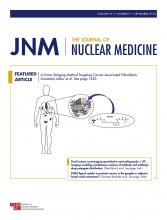Oligometastatic prostate cancer: Jadvar provides an overview of this complex disease setting and recommends increased research and analytic foci on precise and optimal molecular imaging and clinical management techniques.
Page 1338
Imaging cancer metabolism: Pantel and colleagues discuss the underlying biology of metabolic dysregulation in cancer, including glucose, glutamine, and acetate metabolism and associated imaging strategies.
Page 1340
Covalent labels for PET: Pichler and colleagues offer an educational overview of the radiochemistry of PET tracers that exhibit a covalently bound radiolabel with 11C, 13N, and 18F, including the tracer life cycle from radionuclide production through quality control.
Page 1350
PET metallomics: Bartnicka and Blower report on the growing availability of positron-emitting isotopes of key essential metals, particularly 64Cu, 63Zn, and 52Mn, that provide new tools with which to image disturbed metal homeostasis.
Page 1355
SUV and tumor progression: Cornelis and colleagues investigate whether intraprocedural 18F-FDG PET/CT can serve as a biomarker and predictor of local tumor progression after percutaneous ablation of colorectal liver metastases.
Page 1360
SPECT/CT for lung shunt quantification: Dittmann and colleagues evaluate quantitative SPECT/CT for hepatopulmonary fraction assessment in a prospective clinical cohort scheduled to undergo selective internal radiotherapy for liver metastases.
Page 1366
99mTc-PSMA vs 99mTc-MDP: Rathke and colleagues assess the rates of detection of bone metastases with these 2 tracers in patients with known advanced-stage osseous metastasized prostate cancer.
Page 1373
18F-Fludarabine for lymphoma imaging: Chantepie and colleagues describe a first-in-humans clinical study of 18F-fludarabine PET in patients with diffuse large B-cell lymphoma or chronic lymphocytic leukemia.
Page 1380
HER2-selective tyrosine kinase inhibitor: Tang and colleagues detail the development of a 125/131I-labeled agent targeting human epidermal growth factor receptor type 2 and evaluate it in HER2-positive and -negative subcutaneous human breast cancer xenografts.
Page 1386
68Ga-PSMA11 PET/CT in mice: Lückerath and colleagues explore the reproducibility of imaging signal and relationship between quantitative cell-surface prostate-specific membrane antigen expression and prostate cancer lesion detectability with this tracer in small animal PET/CT.
Page 1392
Immuno-PET/NIRF in pancreatic cancer: Zettlitz and colleagues develop a dual-labeled probe based on A2 cys-diabody targeting of the cell-surface prostate stem cell antigen, with potential for both whole-body PET in pancreatic cancer and near-infrared fluorescence surgical guidance.
Page 1398
PSMA ligand uptake in ganglia: Rischpler and colleagues explore physiologic prostate-specific membrane antigen ligand uptake on 68Ga-PSMA-HBED-CC PET in cervical, celiac, and sacral ganglia of the sympathetic trunk as a confounding factor in imaging lymph node metastases in prostate cancer.
Page 1406
Fibroblast-activating protein: Siveke offers perspective on the potential for therapeutic targeting of cancer-associated fibroblasts, a multifunctional and abundant cell population in tumor microenvironments, and previews 2 associated articles in this issue of JNM.
Page 1412
Theranostic ligands for FAP: Lindner and colleagues research in preclinical studies and in preliminary human testing a radiolabeled fibroblast activation protein inhibitor with promise for imaging and targeted therapy of tumors with high activated fibroblast content, such as breast cancer.
Page 1415
Imaging of activated fibroblasts: Loktev and colleagues describe an iodinated and a DOTA-coupled radiotracer based on a fibroblast activation protein–specific enzyme inhibitor and evaluate them in vitro and in tumor-bearing animals.
Page 1423
Myocardial perfusion in Chagas disease: Oliveira and colleagues investigate the occurrence of myocardial perfusion defects and correlated regional changes to histology in an experimental hamster model of chronic Chagas cardiomyopathy.
Page 1430
Metabolic pattern of iRBD: Meles and colleagues identify the 18F-FDG PET metabolic pattern underlying idiopathic rapid eye movement sleep behavior disorder and compare it with the known Parkinson disease pattern.
Page 1437
Age and 5-HT6 receptors in men: Radhakrishnan and colleagues explore in healthy men the effects of age on 5-HT6 receptor availability using 11C-GSK215083, a PET ligand with affinity for 5-HT6 in the striatum and 5-HT2A in the cortex.
Page 1445
Fetal dosimetry in PET/CT: Xie and colleagues expand on previously developed computational phantoms for pregnant women and describe a personalized model for patient-specific radiation dose in a twin pregnancy.
Page 1451
Imaging bystander payload distribution: Cilliers and Thurber offer perspective on antibody–drug conjugates, a promising class of therapeutics for molecular targeting, and preview an article in this JNM issue on dual-isotope tracking of both antibody and payload with these conjugates.
Page 1459
CIQA for ADC intratumoral distribution: Ilovich and colleagues present a dual-isotope cryoimaging quantitative autoradiography methodology combined with 3D imaging and analysis for simultaneous study of both antibody and payload distribution of antibody–drug conjugates in tissue.
Page 1461
Impact of PET/MR motion correction: Manber and colleagues test the ability of a PET/MR-based predictive model to correct PET respiratory motion and determine whether it can improve lesion detectability and quantitation and reduce image artifacts.
Page 1467
PET/DCE-MR concurrent motion correction: Fuin and colleagues detail an approach for concurrent reconstruction of respiratory motion–compensated abdominal dynamic contrast-enhanced MR and PET imaging data in an integrated PET/MR scanner.
Page 1474
PET/CT respiratory motion correction: Lu and colleagues establish a framework to address artifacts from mismatches between respiration-gated PET images and CT attenuation correction maps, as well as other limitations of current respiratory motion correction methods.
Page 1480
- © 2018 by the Society of Nuclear Medicine and Molecular Imaging.







